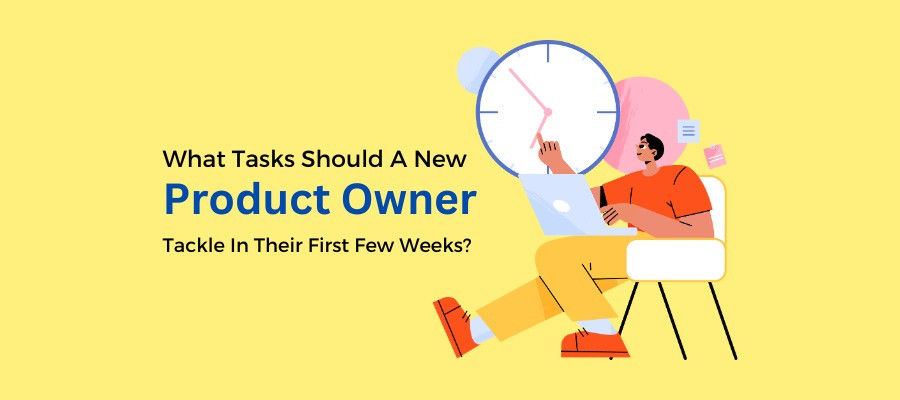What Tasks Should A New Product Owner Tackle In Their First Few Weeks?

Are you stepping into the new role of Product Owner? As you gear up to fulfill your work responsibilities as a CSPO, always remember that you are in charge of the Agile team you lead! Your responsibilities go beyond creating the Product Roadmap and managing Product Backlog Items. Your priority should be ensuring the product's success. However, navigating your first few weeks as a Product Owner can become challenging if you aren’t well-prepared!
That’s why this guide will help you outline the essential tasks and strategies to kickstart your journey as a Product Owner! It’s time to make a meaningful impact from the start!
Week 0: Prepare for Success
Before diving into your new role, take the time to prepare yourself by revisiting fundamental Agile and product management principles:
- Refresh your knowledge: Revisit the Agile Manifesto, Scrum framework, and product management fundamentals to ensure a solid understanding of your role.
- Understand stakeholder demands: Familiarize yourself with the goals and expectations of stakeholders, including customers, users, and internal teams.
- Study the product: Dive deep into its history, roadmap, and backlog to gain insights into its current state and future direction.
- Build relationships: Connect with key stakeholders, including the Scrum Master, Development Team, and other relevant departments, to establish rapport and alignment.
Week 1: Be Vigilant To Listen and Learn
In your first week, focus on listening and learning from your team and stakeholders to gather valuable insights:
- Meet the team: Introduce yourself to the Scrum Team including Scrum Master & Developers, and other stakeholders, and learn about their roles, expertise, and perspectives.
- Attend Scrum events: Participate in Sprint Planning, Daily Standups, and other Scrum events to understand the team's dynamics, progress, and challenges.
- Review the backlog: Analyze the Product Backlog to identify priorities and existing dependencies for refinement or clarification.
- Engage with stakeholders: Schedule meetings to gather feedback, clarify requirements, and align expectations regarding the product vision and goals.
Week 2: Establish Work Priorities And Direction
During your second week, focus on setting clear priorities and direction for the product:
- Define the Product Vision: Articulate a compelling vision for the product that aligns with business objectives and meets the needs of stakeholders and users.
- Prioritize the backlog: Collaborate with the Scrum Team and stakeholders to prioritize Product Backlog Items based on value, dependencies, and risks.
- Refine user stories: Work closely with the Scrum Team to refine user stories, acceptance criteria, and definition of done to ensure clarity and alignment.
- Align with stakeholders: Communicate the product vision, priorities, and roadmap to stakeholders to foster alignment and support for upcoming initiatives.
Week 3: Embrace Collaboration And Decision-Making
In your third week, focus on facilitating collaboration and decision-making to drive progress:
- Empower the team: Provide guidance and support to the Scrum Scrum Team, encouraging autonomy, creativity, and accountability in delivering value.
- Make informed decisions: Use data, feedback, and insights to make informed decisions about the Product Backlog, priorities, and trade-offs.
- Resolve impediments: Identify and address organizational obstacles or bottlenecks that hinder the team's progress, collaborating with the Scrum Master and stakeholders to find solutions.
Week 4: Measure The Product Success And Iterate
In your final week of the month, focus on measuring success, gathering feedback, and iterating on your approach:
- Evaluate progress: Use metrics, feedback, and retrospectives to assess the team's progress toward achieving sprint goals and delivering value to stakeholders.
- Gather feedback: Solicit feedback from stakeholders, users, and the Development Team to identify areas for improvement and refinement.
- Iterate and adapt: Use feedback and insights to iterate on the Product Backlog, priorities, and processes, continuously improving the product and the way of working.
- Celebrate achievements: Recognize and celebrate milestones, achievements, and successes with the team and stakeholders, fostering motivation and engagement.
Overcoming Common Challenges & Outshining Yourself As A New Product Owner!
As a new Product Owner, you may encounter various challenges. Here's how to address some of them with confidence:
- Managing stakeholder expectations: Communicate openly and regularly with stakeholders, setting clear expectations and priorities to manage their expectations effectively.
- Balancing competing priorities: Prioritize Product Backlog Items based on value, dependencies, and risks, collaborating with stakeholders and the Development Team to make informed decisions.
- Handling changing requirements: Embrace change and uncertainty, leveraging Agile principles and practices to adapt quickly to evolving requirements and market conditions.
- Building trust with the team: Establish trust and credibility with the Development Team through transparency, collaboration, and accountability, demonstrating your commitment to their success.
To further enhance your skills and knowledge as a Product Owner, consider joining communities such as Product Management Reddit. Connect with fellow peers, share insights, and learn from industry experts.
Indeed, you'll be well-equipped to drive product success and deliver value to stakeholders and users as a Product Owner. Embrace the challenges and opportunities that come your way, and continue learning and growing in your role.
Reference:
https://resources.scrumalliance.org/Article/im-new-product-owner-responsibilities
https://www.atlassian.com/agile/product-management/tips-for-new-product-manager
https://www.forbes.com/sites/forbesdigitalgroup/2020/12/16/7-tips-for-new-product-owners/?sh=371ef3b5d521



